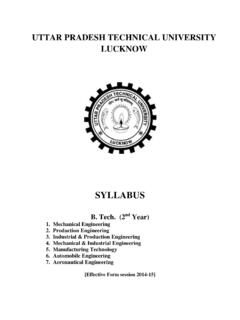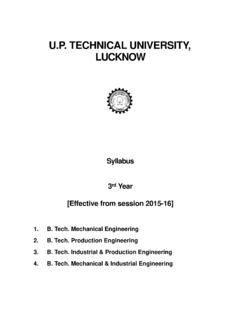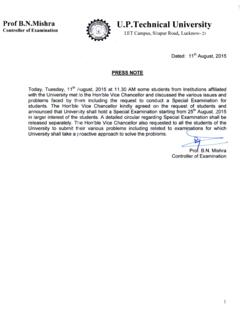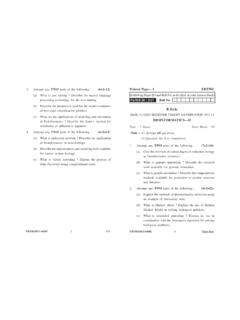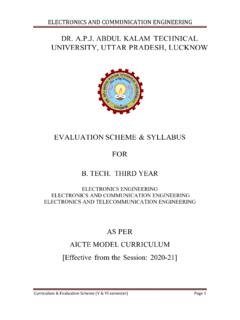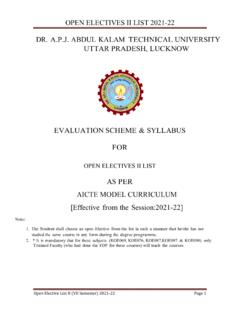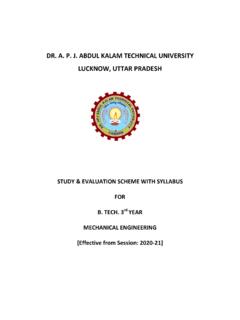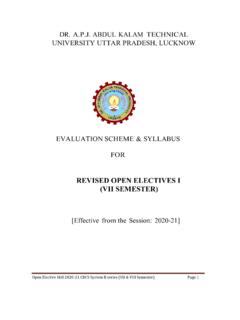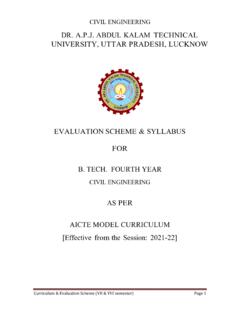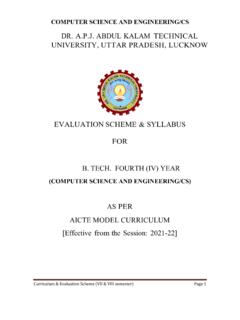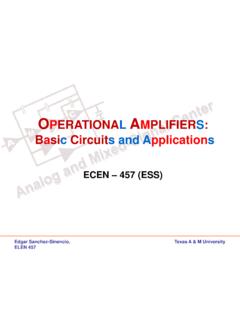Transcription of DR. A. P. J. ABDUL KALAM TECHNICAL UNIVERSITY LUCKNOW ...
1 DR. A. P. J. ABDUL KALAM TECHNICAL UNIVERSITY LUCKNOW , UTTAR PRADESH STUDY & EVALUATION SCHEME WITH SYLLABUS FOR B. TECH. 4th YEAR MECHANICAL ENGINEERING [Effective from Session: 2021-22] Page 2 B. Tech Mechanical Engineering Evaluation Scheme Effective in Session 2021-22 SEMESTER- VII Sl. No. Code Subject Periods Evaluation Scheme End Semester Total Credit L T P CT TA Total PS TE PE 1 HSMC-1/HSMC-2 3 0 0 30 20 50 100 150 3 2 Departmental Elective-IV 3 0 0 30 20 50 100 150 3 3 Departmental Elective-V 3 0 0 30 20 50 100 150 3 4 Open Elective-II 3 0 0 30 20 50 100 150 3 5 KME 751 Measurement & Metrology Lab 0 0 2 25 25 50 1 6 KME 752 Mini Project or Internship Assessment* 0 0 2 50 50 1 7 KME 753 Project 0 0 8 150 150 4 8 MOOCs (Essential for Hons. Degree) Total 9 0 12 21 850 18 *The Mini Project or internship (5 - 6 weeks) conducted during summer break after VI semester and will be assessed during VII semester. SEMESTER- VIII Sl.
2 No. Code Subject Periods Evaluation Scheme End Semester Total Credit L T P CT TA Total PS TE PE 1 HSMC-2/HSMC-1 3 0 0 30 20 50 100 150 3 2 Open Elective-III 3 0 0 30 20 50 100 150 3 3 Open Elective-IV 3 0 0 30 20 50 100 150 3 4 KME 851 Project 0 0 18 100 300 400 9 5 MOOCs (Essential for Hons. Degree) Total 9 0 18 27 850 18 Page 3 It is suggested that the students should choose Departmental Electives Specialization wise that will support them to gain enough learning of the chosen Specialization. Department Electives Specialization-1 Specialization-2 Specialization-3 Specialization-4 Specialization-5 Specialization Manufacturing and Automation Automation and Industry Design and Analysis Thermal Engineering Automobile Engineering Sem VII Code KME 071 KME 072 KAU 072 Departmental Elective-IV Additive manufacturing (Common to all Three Specializations) HVAC systems Hybrid Vehicle Propulsion Sem VII Code KME 073 KME 074 KME 075 KME 076 KAU 073 Departmental Elective-V Mathematical Modeling of Manufacturing Processes Machine Learning Computer Graphics and product modeling Power Plant Engineering Vehicle Body Engineering & safety Page 4 Course Outcome (CO): The Students will be able to Bloom Taxonomy CO-1 Understand the basic principles of instrumentation for measurement of surface finish, strain, temperature, pressure and flow.
3 K2 CO-2 Understand the principle and operation of Coordinate Measuring Machine (CMM). K2 CO-3 Apply Sine Bar, Slip Gauges, Bevel Protractor, Stroboscope, Dial Indicator etc. for measurement of different attributes. K3 CO-4 Apply the basic concepts of limits, fits & tolerances for selective assembly. K3 List of Experiments Minimum 08 experiments out of following (or such experiment) are to be performed: 1. Measurement of effective diameter of a screw thread using 3 wire method. 2. Measurement of angle using sine bar & slip gauges. 3. Study of limit gauges. 4. Study & angular measurement using Bevel protector. 5. Study of different types of comparators . 6. Study of important parameters of surface finish. 7. Study of principle and operation of coordinate-measuring machine (CMM). 8. Use of dial indicator and V Block to check the circularity and plot the polar Graph. 9. Study and understanding of limits, fits & tolerances in assembly of machine components.
4 10. Study and understanding of different methods of measurement of pressure. 11. Study and understanding of different methods of measurement of temperature. 12. Study and understanding of measurement of strain using strain gauges. 13. Study and understanding of different methods of measurement of flow. 14. Study and understanding of different methods of measurement of vibration/power. 15. Study and understanding of measurement of displacement using LVDT. Subject Code: KME 751 Measurement & Metrology Lab L T P : 0 0 2 Credits: 1 Page 5 Semester VII: Departmental Elective IV Specialization Manufacturing and Automation Automation and Industry Design and Analysis Subject Code: KME 071 Additive manufacturing L T P : 3 0 0 Credits: 3 Course Outcome: Student will be able to Bloom Taxonomy CO 1 Understanding the basics of additive manufacturing/rapid prototyping and its advantages and disadvantages K2 CO 2 Understanding the role of additive manufacturing in the design process and the implications for design.
5 K2 CO 3 Understanding the processes used in additive manufacturing for a range of materials and applications K2 CO 4 Understand the various software tools, processes and techniques that enable advanced/additive manufacturing and personal fabrication. K2 CO 5 Apply knowledge of additive manufacturing for various real-life applications K3 UNIT I Introduction History and Advantages of Additive Manufacturing, Distinction Between Additive Manufacturing and CNC Machining, Types of Additive Manufacturing Technologies, Nomenclature of AM Machines, Direct and Indirect Processes; Prototyping, Manufacturing and Tooling. Layer Manufacturing Processes: Polymerization, Sintering and Melting, Extrusion, Powder Binder Bonding, Layer Laminate Manufacturing, Other Processes; Aerosol printing and Bio plotter. UNIT II Development of Additive Manufacturing Technology Computer Aided Design Technology, Other Associated Technology, Metal and Hybrid Systems.
6 Generalized Additive Manufacturing Process Chain; The Eight Steps in Additive Manufacturing, Variation from one AM Machine to Another, Metal System, Maintenance of Equipment, Material Handling Issue, Design of AM. UNIT III Additive Manufacturing Processes Vat Photo polymerization; Materials, Reaction Rates, Photo polymerization Process Modelling, Scan Patterns Powder Bed Fusion Processes; Material, Powder Fusion Mechanism, Process parameters and Modeling, powder Handling Extrusion Based System; Basic principles, plotting and Path Control, Other Systems Page 6 Material Jetting; Materials, Material Processing Fundamentals, Material Jetting Machines Directed Energy Deposition Processes; General DED Process Description, Material Delivery, DED systems, Process parameters , Processing-Structure-Properties Relationships UNIT IV: Design & Software Issues Additive Manufacturing Design and Strategies; Potentials and Resulting Perspectives, AM based New Strategies, Material Design and Quality Aspects for Additive Manufacturing; Material for AM, Engineering Design Rules for AM.
7 Software Issue for Additive Manufacturing; Introduction, Preparation of CAD Models: The STL file, Problem with STL file, STL files Manipulation, Beyond the STL file, Additional Software to Assist AM UNIT V Material Design & Quality Aspects Machines for Additive Manufacturing, Printers, Secondary Rapid Prototyping processes, Intellectual Property, Product Development, Commercialization, Trends and Future Directions in Additive Manufacturing, Business Opportunities Applications Aerospace, Automotive, Manufacturing, Architectural Engineering, Art, Jewellery, Toys, Medical, Biomedical, Dental, Bio-printing, Tissue & Organ Engineering and many others. Books and References: 1. Additive Manufacturing Technologies: Rapid Prototyping to Direct Digital Manufacturing, by- Ian Gibson , DSavid W. Rosen , Brent Stucker, Springer. 2. Understanding Additive Manufacturing, by- Andreas Gebhardt, Hanser. 3. Additive Manufacturing, by- AmitBandyopadhyay, Susmita Bose, CRC Press.
8 4. Rapid Prototyping: Principles and Applications, by -Chee Kai Chua, Kah Fai Leong, Chu Sing Lim. Page 7 Semester VII: Departmental Elective IV: Specialization Thermal Engineering Subject Code: KME 072 HVAC systems L T P : 3 0 0 Credits: 3 The students will be able to Bloom Taxonomy CO1 Understand the basics concepts of HVAC and various HVAC systems. K2 CO2 Understand the use of refrigerants with their respective applications and its future trends. K2 CO3 Understand the use of different auxiliary systems used in HVAC systems. K2 CO4 Apply the basic laws for thermodynamic analysis of different processes involved in HVAC systems. K3 CO5 Apply the basic concepts to calculate the HVAC loads for different applications. K3 CO6 Apply the concepts of psychrometry to design HVAC systems for different applications K3 Unit-I (8 Hours) Advanced Vapour Compression Cycles: Review of vapour compression cycle, Effect of superheating, subcooling, condenser pressure and evaporator pressure on COP, Transcritical cycle, Ejector refrigeration cycle.
9 Presentation of cycle on P-h and T-s chart. Refrigerants: Classification of Refrigerants, CFC, HFC, HCFC, Azeotropic, Zeotropic, Natural refrigerant, Secondary Refrigerant, Anti-freeze solution, Phase Changing Materials. Desired properties of refrigerants, Requirements for refrigerant, Classification based on safety, Refrigerant oils and applications, Properties and uses of commonly used refrigerant, Greenhouse effect, Global warming, Future Refrigerants like Hydrofluoro-Olefines Unit-II (7 Hours) Review of Psychrometry: Psychrometric properties, Psychrometric chart and Psychrometric processes, Psychrometric process in Air conditioning equipment: By pass factor, cooling and dehumidifying coils, Apparatus dew point (ADP), Heating coils, air washer, use of hygroscopic solution in Air Washer, adiabatic dehumidifier, water injection, stream injection, Summer Air conditioning, Winter Air conditioning, Sensible heat factor (SHF), Grand Sensible heat factor (GSHF) Design Condition.
10 Choice of inside design condition- cold storage, Industrial air conditioning, comfort air conditioning, Human comfort, Outside design condition Unit-III (7 Hours) Heat Pump: Introduction, package heat pump with reversible cycle, decentralized heat pump, heat pump with a double bundle condenser, industrial heat pump Page 8 Ventilation: Introduction, purpose of ventilation, Natural ventilation, mechanical ventilation, tunnels ventilation, mine ventilation, Natural ventilation, and mechanical ventilation. Air Conditioning system: Introduction, Unitary system, central air conditioning system, directs expansion system, all water system, all air system, air water system. Unit-IV: (11 Hours) Load Calculation: Solar radiation, Heat gain through glass- Calculation of solar heat gain through ordinary glass tables-shading devices- effect of shading devices. Fabric heat gain, over all heat transfer coefficient, Periodic heat transfer through walls and roofs.
